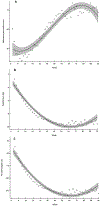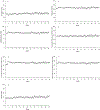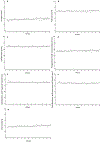Changes in body weight, adherence, and appetite during 2 years of calorie restriction: the CALERIE 2 randomized clinical trial
- PMID: 32144378
- PMCID: PMC7415503
- DOI: 10.1038/s41430-020-0593-8
Changes in body weight, adherence, and appetite during 2 years of calorie restriction: the CALERIE 2 randomized clinical trial
Abstract
Background/objectives: The Comprehensive Assessment of Long-term Effects of Reducing Intake of Energy Phase 2 (CALERIE) study showed that individuals who are nonobese were able to undergo significant calorie restriction (CR), yet the time course changes in adherence, weight, and appetite are unknown. This analysis aimed to investigate the time course changes in adherence, body weight, and appetite during the CALERIE study.
Subjects/methods: Overall, 143 participants (body mass index: 21.9-28.0 kg/m2) were randomized to a CR group that aimed to achieve 25% CR for 2 years. Throughout the intervention, body weight was measured, and appetite was assessed through visual analogue scales. Algorithms were utilized with body weight measurements to calculate adherence percentile score. Participants targeted an adherence percentile score of 50, though being between 80 (lowest acceptable adherence) and 10 (highest acceptable adherence) was adequate. Polynomial regression analyses were used to assess time course changes.
Results: Polynomials indicated that adherence percentile score increased above 50 after approximately week 20, although adherence remained acceptable (adherence percentile score less than 80) (R2 = 0.89; P < 0.001). Weight loss occurred until approximately week 60 and then plateaued (R2 ≥ 0.92; P < 0.001). Hunger and thirst increased (R2 ≥ 0.30; P < 0.001), but the total increase in scale scores were <10 mm throughout the intervention.
Conclusions: In individuals who are nonobese, adherence to 25% CR declines after 20 weeks, but 2 years of CR that stimulates a meaningful reduction in weight, promotes aging-related benefits and negligibly affects appetite is viable.
Conflict of interest statement
Conflicts of interest
The authors declare no conflict of interest.
Figures




References
-
- Doucet E, St-Pierre S, Alméras N, Tremblay A. Relation between appetite ratings before and after a standard meal and estimates of daily energy intake in obese and reduced obese individuals. Appetite. 2003;40:137–43. - PubMed
-
- McGuire MT, Wing RR, Klem ML, Lang W, Hill JO. What predicts weight regain in a group of successful weight losers? J Consult Clin Psychol. 1999;67:177–85. - PubMed
-
- Sumithran P, Prendergast LA, Delbridge E, Purcell K, Shulkes A, Kriketos A, et al. Long-term persistence of hormonal adaptations to weight loss. N Engl J Med. 2011;365(17):1597–604. - PubMed
Publication types
MeSH terms
Grants and funding
LinkOut - more resources
Full Text Sources

